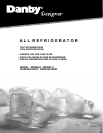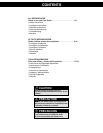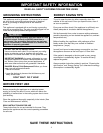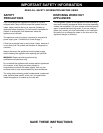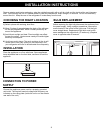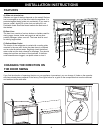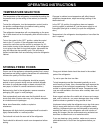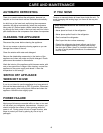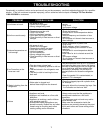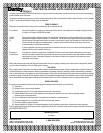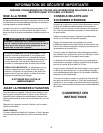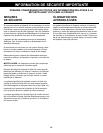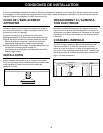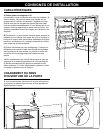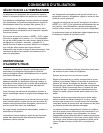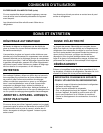
OPERATING INSTRUCTIONS
STORING FRESH FOODS
Proper use of the appliance, adequately packed food, correct
temperature and taking hygienic precautions will substantially
influence the quality of the food stored.
Foods to be stored in the refrigerator should be properly
packed so as to prevent mixing various moisture degrees
and odors (in polyethylene bags or sheets, aluminum foil,
wax paper, or stored in covered containers or bottles.)
Before storing food in the refrigerator, remove excessive
packaging (like yogurt in multi-package.)
Pack systematically and make sure that foodstuffs do not
touch each other (various odors may mix.) Assure adequate
air circulation around packages.
Never store flammable, volatile or explosive
substances.
Beverages with high alcohol percentage should be stored in
tightly sealed bottles in a vertical position.
Food should not touch the rear wall of the refrigerator.
Foods should be allowed to reach room temperature before
storing.
Crispy and delicate foods should be stored in the coldest
parts of the refrigerator.
Try not to open the door too often.
To test temperature set the thermostat gradually so as to
avoid freezing of foods. Use a thermometer and measure the
temperature in the individual compartments. Place the ther-
mostat in a glass vessel filled with water. Temperature read-
ings are most realiable a few hours after a steady state condi-
tion is reached.
Some organic solutions like volatile oils in lemon and orange
peel, acid in butter etc. can cause damage when they contact
plastic surfaces or gaskets for long periods of time.
Unpleasant odors inside the refrigerator are a sign that some-
thing is wrong with the food or that your refrigerator needs
cleaning. Unpleasant odors can be eliminated or reduced by
washing the interior of the refrigerator with mild solution of
water and vinegar. We also recommend using activated car-
bon filters to clean the air or to neutralize odors.
If you are planning a long vacation, make sure to remove
perishable articles of food from the appliance before you
leave.
TEMPERATURE SELECTION
The temperature of the refrigerator is controlled by setting the
thermostat knob (on the ceiling of the cabinet) to a desired
setting.
To start the refrigerator, turn the temperature control knob to
the position corresponding to the desired cooling setting
(on the graduated blue dial, Fig.A.)
The refrigerator temperature will vary depending on the quan-
tity of food stored and on the frequency with which the door is
opened.
To turn the control to the “OFF” position, rotate the control
knob to the “0” position. If the refrigerator has been left
unused for some time, set the control to maximum for 2-3
hours before turning to the desired position. If the refrigerator
is not going to be used for long time periods, disconnect the
plug and leave the door partially open. This will help to
prevent mold/mildew from accumulating inside the refrigerator
cabinet.
Changes in ambient room temperature will affect internal
refrigerator temperatures, adjust accordingly setting of the
thermostat knob.
In the OFF (0) position, the appliance does not operate
(cooling system is switched off,) yet the power supply is not
interrupted (the light is on when you open the refrigerator
door.)
Temperature in the refrigerator also depends on how often the
door is opened.
Fig A
5



